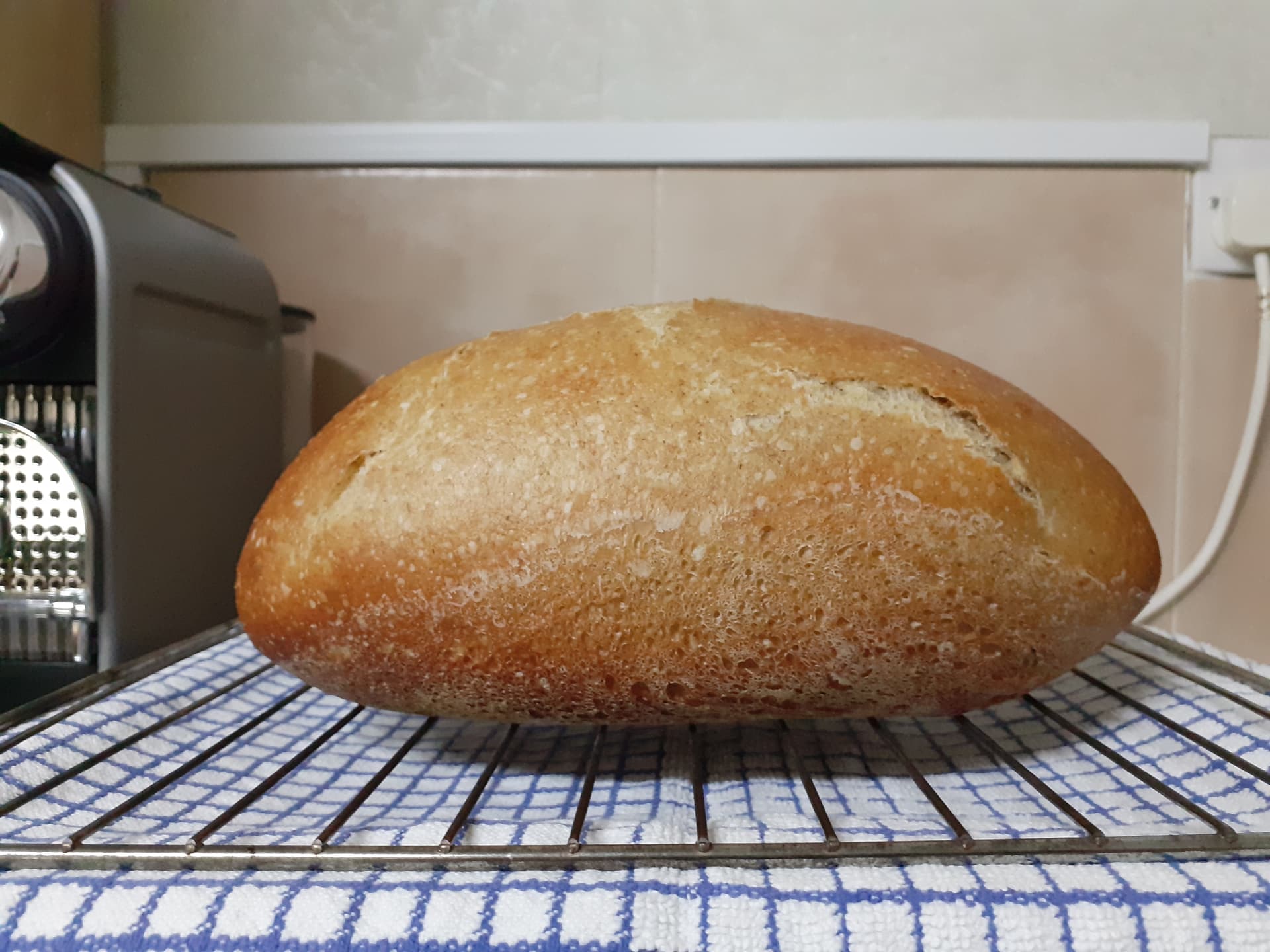
A Tale of Two Pre-Ferments

The experiment…
- One liquid starter fermented at a warmer temperature for a lactic acid flavour.
- A second stiff starter fermented at a cooler temperature for it's acetic acid flavour.
Blend them into one loaf and see how they play against each other.
Pre-Ferment One: The liquid starter…
- 1 tsp rye starter at 100% hydration
- 50g water
- 40g bread flour
Mixed at the same time as the stiff starter then a few hours later placed in a yoghurt maker at 82°F to encourage a lactic acid ferment. My yoghurt maker was playing up and it only got 2-3 hours in there. In that time it peaked and fell. Left it to ferment at room temperature till ready to make the final dough even though it was passed its peak.
Pre-Ferment Two: The stiff starter…
- 1 tsp rye starter at 100% hydration
- 25g water
- 50g flour (30g bread flour + 20g whole rye flour)
Mixed into a stiff dough and left to ripen at room temperature 12-14 hours.
The Final Dough…
- 500g flour (450g bread flour + 50g whole rye flour)
- 300g water (for the autolyse) + extra
- 9g salt
- 25g each! of the two pre-ferments
Method…
- Mix the flour water and pre-ferments (break the low hydration starter up in the water) into a stiff dough and autolyse for 1.5 hours.
- Add the salt plus extra water and combine. Add in enough water till the dough feels right. Should be tacky but not too sticky.
- Bulk ferment for a total of 6 hours from when the autolyse was mixed giving the dough a stretch and fold every hour or so.
- Give the dough one more stretch and fold then refrigerate for 15-16 hours.
- Take the dough out of the fridge and leave at room temperature for one hour.
- Shape and final proof for 3 hours.
- Bake.
Verdict…
A complex flavourful loaf. The tang compliments but doesn’t overpower the flavours coming through. Tasting notes is a lovely biga bread with toasted corn and a nicely rounded yoghurt(y) tang. Very happy with this bake.



At this point I've made a small handful of two preferment breads, and I've never quite been able to tell whether the extra effort paid off, except for the experience.
for your tasting note, you reference both biga and corn. Is it only the taste that has you mention them since neither is included in the formula? Are you referring to the stiff starter as a biga?
Nice work Abe, Alan
The only other two pre-ferment bread i have come across is Hamelman's semolina where he uses a liquid levain and a yeasted biga. And i agree with you... when it comes to semolina/durum the results are the same. Not too sure why both pre-ferments are needed.
My reasoning behind the two sourdough pre-ferments was to encourage a lactic acid ferment in one and an acetic acid in another. Seeing if a balance between the two brings something out in the flavour.
Sometimes a flavour added to a dish is not apparent in itself but it draws something out of the other flavours. Like a pinch of salt in a cake etc. So while I can only comment on what i'm tasting in the final loaf I can't pin down which pre-ferment brought out what. Am I tasting just one or the other or is it the balance of the two?
My reference to a biga is that 'something extra' one can taste from a biga bread rather than it's plain yeasted counterpart. Same here... i'm getting a cross between a well done biga with added yoghurt and toasted corn. The salt is 1.8% bakers percentages but i'm getting a more intense flavour as if there was more. Could be an umami taste (as everyone likes to call it nowadays). Definitely toasted corn cereal notes with a pleasant tang.
That's the best way I can explain it.
Looks like a great bake Abe. Lovely crumb and crust.
The crumb was a pleasant surprise.
Nice experiment and bake Abe. I’ve never tried such a bake using two different preferments that I can recall. I think I’d have to bake two loaves, one using the warm liquid levain and the other the cold stiff levain to compare and see if I could taste a difference.
Thinking about how to improve on this experiment I would need to...
1: Maintain the two types of starters for a little while for them to fully take on their unique characters.
2: Stagger the pre-ferments so they ripen at the same time.
3: Like one - keep the liquid starter at 82°F but unfortunately the yoghurt maker was playing up.
Liquid starters fermented at warmer temperatures will have a more lactic acid profile and cooler stiff starters will encourage acetic acid. And then of course there's the fridge time too.
I like these flavor oriented experiments. They are a good complement to our quest for the perfect crumb. I'm curious how this would compare to a control loaf with just one of the levains, or a levain maintained at the mid point of the two temperature and hydrations.
I do love experimenting. Whatever I did right - be it the two levains or any other factor - i'm very happy with the results. For this experiment to be perfectly done one would have to maintain both pre-ferments as described for them to really change and take on the different qualities and of course bake a loaf with both, two more loaves with one of the levains and one done midway. Then compare and contrast. Those would be the lab conditions. While I like experimenting these loaves would all have to be eaten plus it'll take a lot of time and it's not feasible for me to do so.
It's my understanding that starters are capable of lactic and acetic acid but one can't favour both at the same time and starters are better at producing lactic acid.
For me this experiment has been a success simply because it produced a very tasty loaf.